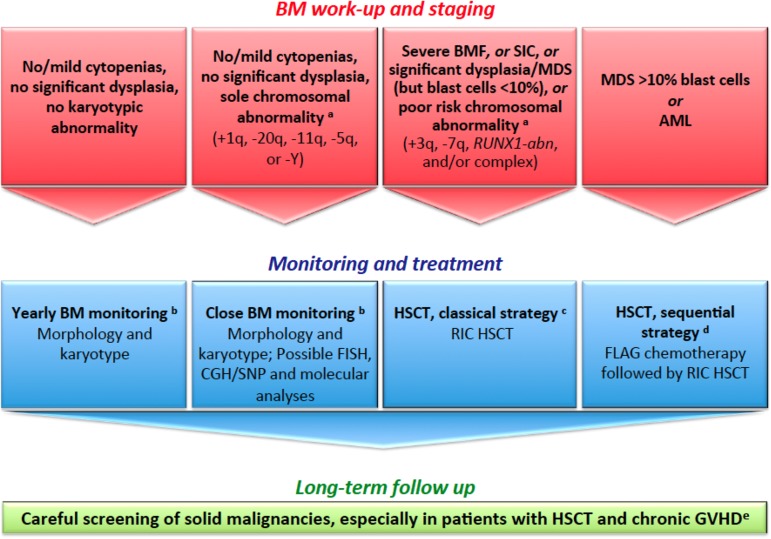Figure 3.
How we diagnose and manage FA patients with MDS and AML. (a) We define provisional cytogenetic/molecular categories by reference to MDS/AML literature in patients with FA50,51 and without FA.52,53 (b) The timing of BM monitoring is discussed, especially because repeated aspiration is poorly tolerated in children, adolescents, and young adults. The overall consensus is that 1 year of BM aspirate is reasonable and should be adapted in response to blood cell count changes, myelodysplastic signs, increased blast proportion, and/or cytogenetic evidence of clonal evolution. (c) Standard RIC regimen combines fludarabine 90 mg/m2 (30 mg/m2 on days −4, −3, and −2) and cyclophosphamide 40 mg/kg (10 mg/kg on days −5, −4, −3, and −2) for MRDs. For MDS/AML, low-dose CY/FLU alone may not suffice as conditioning therapy because of the substantial number of residual host cells early post transplantation with this approach and the risk of relapse; an alternative is to use TBI 2-3 Gy in patients with MDS/AML and an HLA-matched sibling donor.28,54 For MRDs, the conditioning regimen combines fludarabine 120 mg/m2, cyclophosphamide 40 mg/kg, and TBI 2 Gy. GVHD prophylaxis combines mycophenolate acid and cyclosporine. ATG is used in total doses of 5 mg/kg for MUDs only. In CB HSCTs, we do not use ATG in the conditioning regimen. (d) Others do not recommend cytoreduction, except in patients with BRCA2 mutations54; the sequential strategy comprises pretransplant chemotherapy with fludarabine 30 mg/m2 per day for 5 days and cytarabine 1 g/m2 × 2 per day for 5 days with granulocyte colony-stimulating factor injections (FLAG), followed 3 weeks later by a RIC conditioning regimen (4 days of cyclophosphamide 10 mg/kg, 4 days of fludarabine 30 mg/m2, and TBI 2 Gy) delivered during chemotherapy-induced aplasia. ATG is used in total doses of 5 mg/kg for MUDs only. In CB HSCTs, we do not use ATG in the conditioning regimen. (e) Screening for malignancies, including oropharyngeal, dental, and gynecological examinations, forms part of long-term patient care. Naturally, long-term multidisciplinary surveillance is also mandatory for all patients post HSCT. Multiple problems in early age, subsequent HSCT requirements, and continuing poor prognosis in survivors as a result of cancer susceptibility is a source of stress for patients with FA and their families. Adequate psychological support and a coordinated multidisciplinary team with dedicated physicians are the cornerstones to successful management. CGH, comparative genomic hybridization; FLAG, fludarabine/cytarabine/granulocyte colony-stimulating factor; GVHD, graft-versus-host disease; RIC, reduced-intensity conditioning regimen; SIC, severe isolated cytopenia; SNP, single nucleotide polymorphism.

